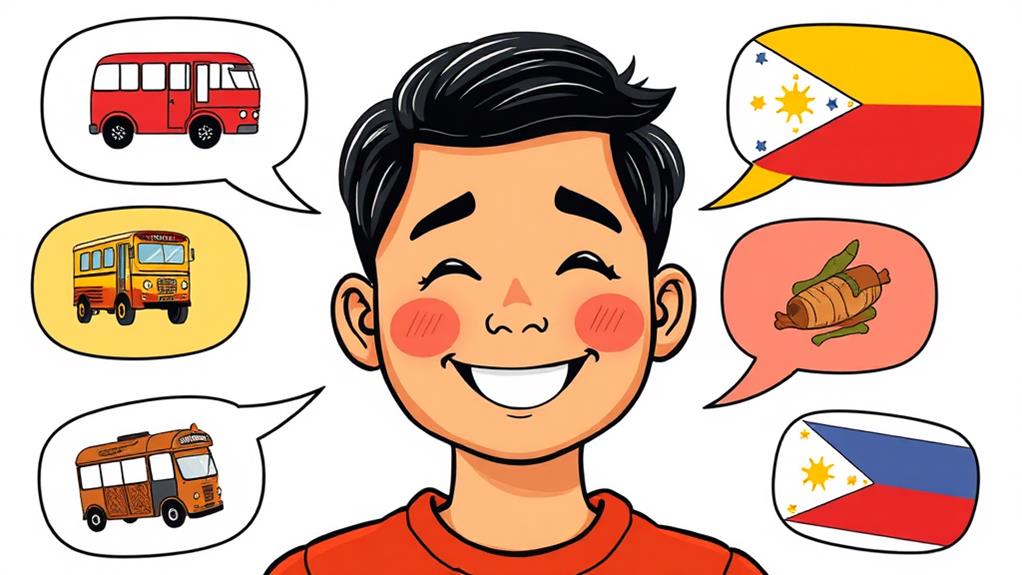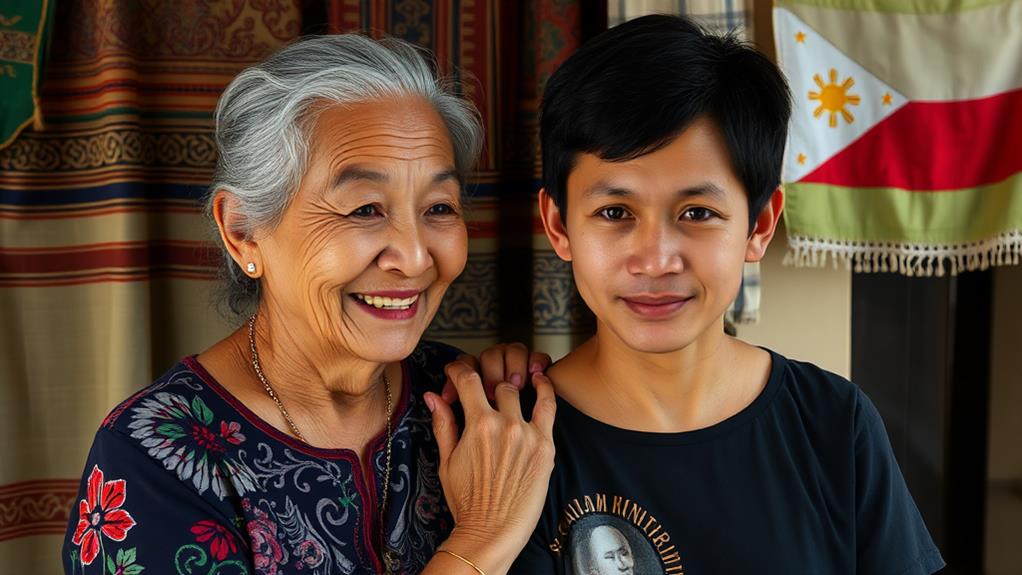Tagalog Expressions for Everyday Interactions
In the Philippines, mastering a few essential Tagalog expressions can help you build connections and navigate everyday interactions more effectively. "Kumusta?" (How are you?) and "Paalam" (Goodbye) are fundamental greetings to get you started.
Showing Gratitude
Expressing gratitude is crucial in any culture. In Tagalog, "Salamat po" (Thank you) is a polite way to show appreciation, while "Maraming salamat" (Thank you very much) conveys deeper gratitude.
Essential Phrases for Agreement, Permission, and Inquiry
In everyday conversations, you'll need phrases like "Sige" (Okay) to show agreement, "Pwede" (May I) to ask for permission, and "Ano ang pangalan mo?" (What's your name?) to inquire about someone's name.
Building Strong Relationships
To communicate effectively in the Philippines, it's essential to learn phrases that help you build strong relationships.
As you continue to learn Tagalog, you'll uncover many more phrases that will help you navigate everyday interactions with confidence.
Common Tagalog Expressions

When communicating with Tagalog speakers, knowing common expressions is crucial for building rapport and showing respect.
Kumusta? is a common Tagalog greeting that means "How are you?" This phrase is used to initiate conversations and show interest in the other person. When responding to Kumusta?, you can say Mabuti (good) or Hindi mabuti (not good), depending on your mood.
To express gratitude, use Salamat, which means "Thank you." For a more polite form, add po to the end, making it Salamat po. This shows respect, especially towards elders.
When it's time to bid farewell, use Paalam, which means "Goodbye."
Sige is a versatile phrase that can mean "Okay" or "Go ahead," often used to express agreement or give permission. If you need to apologize, Pasensya na is a casual way to say "Sorry" or "Excuse me."
Mastering these common Tagalog expressions will help you connect with Filipino speakers and show respect for their culture.
Workplace Communication Essentials
Effective communication is essential for a productive and harmonious workplace. Asking about coworkers' well-being is a great way to build strong relationships. For instance, asking Kumusta? (How are you?) shows interest in your colleagues' lives.
Expressing gratitude is also crucial in the workplace. Saying Salamat po (Thank you) when someone helps you out demonstrates appreciation. Using polite forms, such as Opo (Yes) and Hindi po (No), shows respect, especially towards elders or superiors.
Asking for assistance is vital when you need help. Pwede mo ba akong tulungan? (Can you help me?) encourages collaboration. If you're unsure about something, clarify by asking questions, such as May mga katanungan ba? (Do you have any questions?).
Boosting morale is essential for a positive work environment. Offering words of encouragement like Kaya mo yan! (You can do it!) or Wag kang mag-alala (Don't worry) can make a big difference.
When discussing feedback, using phrases like Pag-usapan natin mamaya (Let's talk about it later) facilitates effective communication and problem-solving.
Expressions of Gratitude and Courtesy

In Tagalog culture, expressing gratitude is essential for social etiquette. To show appreciation, using the right phrases is crucial for demonstrating cultural respect. Salamat po is a polite way to say "thank you," especially when addressing elders or authority figures.
When responding to thanks, walang anuman means "you're welcome." To emphasize gratitude, maraming salamat means "thank you very much." This phrase is useful in various contexts, such as when someone has helped you or provided a favor.
For example, if someone has assisted you in a specific way, salamat sa tulong means "thank you for your help."
Adding po to any expression of gratitude enhances its politeness and demonstrates cultural respect in Filipino interactions. By incorporating these phrases into your daily conversations, you'll show that you value and respect the people around you.
Agreement, Permission, and Inquiry Phrases
When engaging in everyday conversations in Tagalog, expressing agreement, seeking permission, and making inquiries are essential skills. Sige, which means "okay" or "go ahead," is used to show agreement or consent in various situations.
To seek permission, you can say Pakikinggan mo ako, meaning "Listen to me," to gain someone's attention before sharing your thoughts. If you need help, ask Pwede mo ba akong tulungan?, which translates to "Can you help me?" This phrase is a polite way to request assistance in different contexts.
When you want to ask a question or seek input from others, use May suggestion ka ba?, which means "Do you have a suggestion?" This phrase is frequently used in collaborative discussions to invite others' opinions.
To check comprehension, ask Naiintindihan mo ba?, which means "Do you understand?" This phrase ensures the other person grasps what you're saying.
Encouragement and Support Phrases

Tagalog Expressions for Encouragement and Support
When facing a tough situation or needing a confidence boost, Tagalog expressions can provide the necessary motivation. Kaya mo yan!, meaning "You can do it!", is a common phrase used to motivate individuals in challenging situations.
When feeling stressed or overwhelmed, a friend might tell you to Chill lang, or "Just relax", to promote a calm approach. If worried or anxious, someone might say Wag kang mag-alala, or "Don't worry", to reassure you.
In team settings, Good vibes lang! is often used to uplift morale and encourage positivity. When working together on a project, Magkakasama tayo, or "We're in this together!", reinforces solidarity and teamwork, fostering a sense of community.
These Tagalog expressions offer valuable encouragement and support when needed most. By incorporating them into daily interactions, you can provide motivation and reassurance to those around you, helping to build confidence and foster a positive environment.
Team Building and Solidarity
Building a strong team relies on fostering an environment of unity and cooperation. Unity is key to a successful team, as it promotes collaboration and collective effort among colleagues.
In team building, certain Tagalog expressions can help promote solidarity. These expressions include:
Magkasama, which emphasizes the importance of unity in team building and collaboration among colleagues. For instance, when working on a project, team members should work together to achieve a common goal.
Kooperasyon highlights the need for teamwork and collective effort to achieve common goals in the workplace. For example, in a marketing team, each member contributes their skills to create a successful campaign.
Pagkakaisa signifies the importance of unity in fostering a supportive and harmonious team environment. This can be achieved by encouraging open communication and respecting each other's opinions.
Suporta reflects the value of encouraging one another to overcome challenges and achieve success as a team.
Additionally, it's essential to reduce stress to maintain well-being. This can be done by sharing workload and providing emotional support when needed.
Cultural Context and Respect

In the Philippines, respect is a cornerstone of social interactions, and the workplace is no exception. Using common Tagalog expressions and understanding local customs, such as greetings and polite phrases, fosters goodwill and strengthens relationships. For instance, incorporating honorifics like po and opo in your conversations shows respect, especially towards elders and authority figures.
Effective communication is key to building trust and rapport in Filipino culture. Mixing Filipino and English, or "Taglish," is a common way to converse, demonstrating adaptability and comfort in communication among diverse groups. By learning key phrases and expressions, such as "Salamat po" (thank you) and "Oo, gusto ko" (yes, I like it), you're not only aiding in effective communication but also reflecting a commitment to understanding and appreciating Filipino cultural values.
Participating in local festivities and traditions is another way to demonstrate respect for Filipino culture and enhance social bonds with locals. For example, joining in the celebration of Fiesta ng Kaluluwa (Feast of Souls) or Barangay Fiestas (Village Festivals) shows appreciation for the local culture and helps build strong relationships in the workplace and community.
How Do Tagalog Slang Words Relate to Common Expressions and Their Meanings?
Tagalog slang words to learn often stem from playful variations of common expressions, reflecting Filipino culture’s creativity and humor. For instance, “lodi” (idol) and “petmalu” (malupet or awesome) showcase how everyday language is reshaped to convey the same meanings with a modern twist, making communication more relatable and lively.
Everyday Conversational Phrases
Mastering everyday conversational phrases in Tagalog is crucial for a positive experience in the Philippines. It allows you to connect with locals and demonstrate respect for their culture.
To initiate friendly conversations, use Kumusta?, which means "How are you?" This common greeting helps break the ice and shows interest in the other person's well-being.
Expressing gratitude is essential, and Salamat po, meaning "Thank you," is a polite way to do so, especially when interacting with elders. This phrase conveys appreciation and respect.
In discussions, Sige, meaning "Okay" or "Go ahead," is used to indicate agreement or permission. This phrase helps facilitate smooth communication and understanding.
When apologizing or seeking understanding, use Pasensya na, which means "Sorry" or "Excuse me." This casual apology helps resolve situations and shows empathy.
Frequently Asked Questions
What Does Chibugan Na Mean?
What does "chibugan na" mean? It's a Tagalog phrase that translates to "eating time" or "let's eat" in a casual and inviting way.
When you say "chibugan na", you're not only announcing mealtime, but also extending a warm invitation to share Filipino food and good company.
In casual gatherings, this phrase sets the tone for a relaxed, social atmosphere, highlighting the importance of communal meals in Filipino culture.
By using "chibugan na", you're embracing local dialects and social etiquette, which fosters connection and camaraderie with friends and family.
What Is Chika in Filipino Slang?
Chika in Filipino slang refers to casual conversations or gossip.
Chika is a popular expression used to initiate informal talks or ask for news updates. In social media, friends use chika to share stories and bond over shared experiences.
Unlike gossip, chika is a lighthearted way to connect with others, reflecting the cultural value of building relationships through storytelling.
In daily conversations, chika helps create a sense of camaraderie. For instance, when friends meet up, they often start with chika about their daily lives, families, or recent events.
This casual exchange of information strengthens their bond and establishes a sense of community.
What Is the Slang for Foreigners in Filipino?
Filipino slang terms for foreigners are commonly used in the Philippines. Two informal terms, "bule" and "kano", are often used to refer to foreigners in a neutral or playful manner.
These slang terms reflect the cultural nuances of the Filipino language, which frequently incorporates humor and local dialects.
The origins of these terms are rooted in the cultural and linguistic evolution of the Filipino language.
"Expat" and "sosyal" are examples of terms that have been created to describe foreigners, while "taga-ibang bansa" remains a more formal way to address them.
What Is Churva in Tagalog Slang?
Churva is a Tagalog slang term that describes something extraordinary or indescribable. It originates from Filipino culture, where it's used to add a lighthearted touch to conversations.
In casual settings, friends use churva when they can't quite put their feelings into words. For instance, when someone experiences an intense emotion or event that's hard to explain, they might say "churva ang feeling ko!" which means "The feeling is just churva!"
While there aren't direct variations of churva, similar expressions like astig (cool) or gulo (chaos) convey similar emotions.
Churva has become a staple in youth slang, reflecting the evolving nature of the Filipino language.